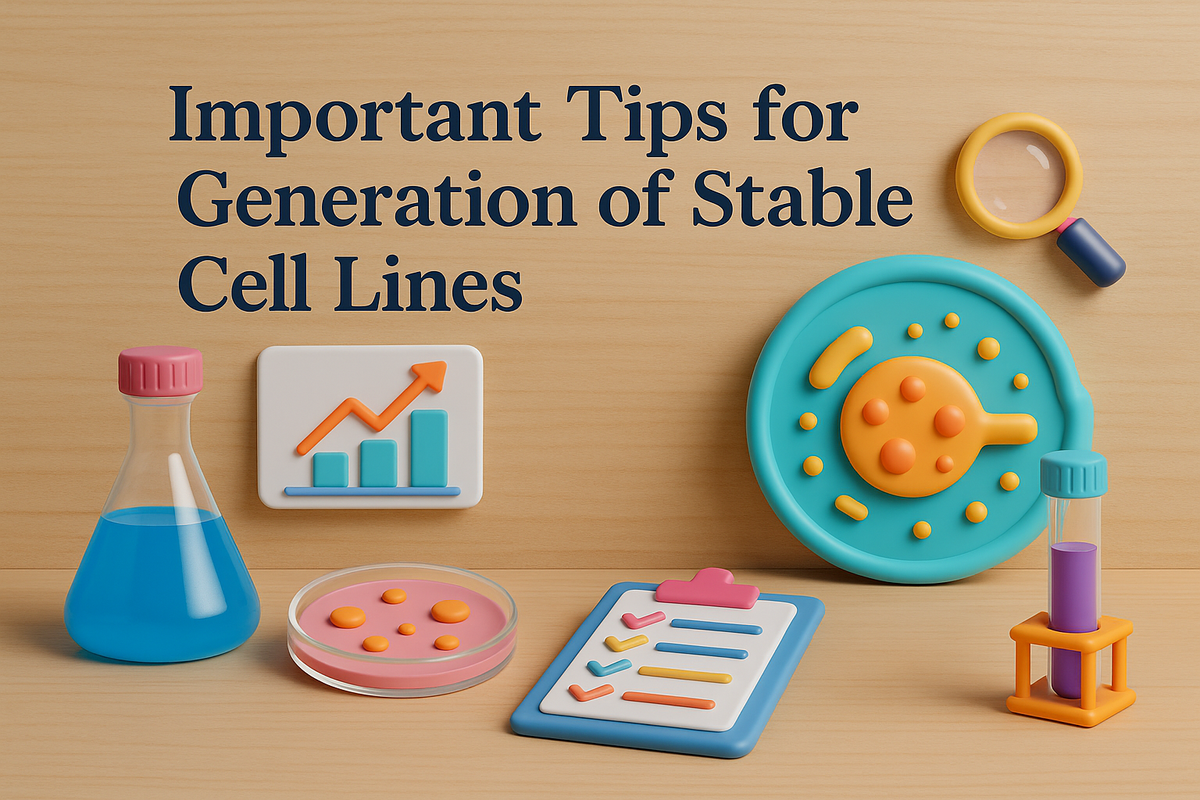🧪 Important Tips for Generation of Stable Cell Lines

In the world of biotechnology and biomedical research, stable cell lines are absolute powerhouses. 🔬 Whether you're manufacturing therapeutic proteins, studying gene function, or conducting drug screenings — stable cell lines are the foundation of successful experiments and products.
However, creating a high-quality, stable cell line isn't as easy as growing regular cells. 🚫 It requires careful planning, strategic steps, and sharp execution. That's why today we bring you the most important tips for the generation of stable cell lines — directly from professional lab experts! 🎯
Let's dive into this fascinating world and make your experiments truly stable and successful! 🚀
🧠 What is a Stable Cell Line?
A stable cell line is a population of cells that has stably integrated foreign DNA into its genome, allowing continuous and consistent expression of a gene of interest over multiple generations.
✅ Compared to transient transfection (short-lived), stable cell lines are reliable for:
Long-term protein production 🧪
Drug development 💊
Gene function studies 🧬
Biomanufacturing 🏭
Sounds important, right? Let's learn how to generate them perfectly! 🎓
📋 Step-by-Step: Important Tips for Stable Cell Line Generation
Below are proven, expert-approved steps to maximize your success when developing stable cell lines.
1️⃣ Choose the Right Host Cell Line 🧫
Your host cell is the foundation of everything.
Different projects need different cells, like:
CHO Cells (Chinese Hamster Ovary) 🐹: Widely used in biotech.
HEK293 Cells (Human Embryonic Kidney) 🧬: Popular for viral vector production.
NS0 and SP2/0 (Mouse Myeloma Cells): Ideal for monoclonal antibody production.
🎯 Pro Tip: Pick a host that's easy to culture, fast-growing, and has regulatory acceptance if it's for therapeutics.
2️⃣ Optimize Your Vector Design 🧬
A strong expression vector ensures efficient gene integration and protein production.
🛠️ Key vector elements:
Strong promoter (e.g., CMV promoter)
Selectable marker (e.g., neomycin, hygromycin resistance)
Origin of replication (for plasmid maintenance)
📌 Make sure your vector also includes:
PolyA signal
Reporter genes (like GFP) for easy screening 🎥
3️⃣ Use Highly Efficient Transfection Methods 💉
Getting DNA inside the cell matters big time.
⚙️ Popular transfection methods:
Chemical (e.g., Lipofectamine 🧴)
Electroporation (electric pulses ⚡)
Viral transduction (using lentivirus or retrovirus 🦠)
Choose the method based on:
Cell type
DNA size
Efficiency needed
4️⃣ Apply Selective Pressure Correctly 🚦
After transfection, apply a selective agent to kill untransfected cells.
Examples of selective antibiotics:
G418 (Geneticin) 💊
Puromycin 💉
Hygromycin B 🔬
🎯 Tip: Always run a "kill curve" first to determine the optimal concentration of antibiotic for your cell type.
5️⃣ Screen and Clone Smartly 🧪
Not all surviving cells are high expressers!
🔍 Screen clones for:
Expression level (e.g., via Western blotting, ELISA)
Genetic stability (karyotyping 📸)
Productivity over multiple passages 📈
Use techniques like:
Limiting dilution
FACS sorting (Fluorescence-activated cell sorting)
This ensures you pick the best clone, not just a random survivor. 🌟
6️⃣ Monitor Expression Over Time 🕰️
Stability is key 🔐.
After selection and screening:
Monitor expression over weeks or even months.
Re-verify genetic integration.
Freeze multiple vials early for safety (master cell bank).
📢 Remember: Even a great clone can lose expression over time if not handled carefully!
7️⃣ Maintain Optimal Culture Conditions 🌡️
Consistency is everything in stable cell lines.
⚡ Critical parameters:
pH 📈
Temperature 🌡️
Nutrient levels 🥼
Passage number 📅
Small changes can make big differences in protein yield and gene expression.
8️⃣ Ensure Mycoplasma-Free Cultures 🧹
⚠️ Mycoplasma infection = silent killer of experiments.
Use routine testing methods like:
PCR assays 🔬
ELISA kits 🧪
Contaminated cultures ruin months of hard work — always test and maintain sterility!
9️⃣ Document Everything 📋
Professional labs record every step, every change, every observation.
✅ Keep logs of:
Vector maps
Transfection protocols
Antibiotic concentrations
Clone selection data
Cell growth curves
Documentation ensures reproducibility and compliance. 📚
🔟 Partner with the Right Experts 🤝
Sometimes, collaborating with an experienced SEO team for your biotech website can boost your brand visibility too!
Companies like SEO Company In Mumbai are experts in showcasing complex scientific work to the right audience using smart digital strategies. 🚀
When your amazing scientific achievements are properly visible online, the opportunities multiply!
🧬 Key Challenges and How to Overcome Them
Here are common issues and expert solutions:
| Challenge | Expert Solution |
|---|---|
| Low Transfection Efficiency 🚫 | Optimize DNA quality, try alternative methods |
| Slow Growth 📉 | Adjust media supplements, check contamination |
| Genetic Instability ⚡ | Reclone and monitor expression stability |
| Low Protein Yield 🧪 | Enhance promoter strength, fine-tune culture conditions |
🎯 Final Words: Stable Cell Line Success is Within Your Reach!
Building a stable cell line is like building a skyscraper — every step matters. 🏙️
From choosing the right cells to maintaining strict culture practices, every decision impacts your success.
When you follow these tips carefully:
Your productivity increases 📈
Your experiments become reliable ✅
Your biotech innovations shine 💡
And remember, just like stable cells need a good foundation, your online presence needs a strong SEO foundation too! 🚀 Partner with a reliable expert like SEO Company In Mumbai to boost your scientific success beyond the lab! 🌟
📢 Quick Recap: Your Stable Cell Line Checklist
✅ Choose right host
✅ Design powerful vectors
✅ Transfect efficiently
✅ Apply smart selection
✅ Clone the best cells
✅ Monitor long-term
✅ Stay mycoplasma-free
✅ Keep detailed records
✅ Optimize your online visibility





